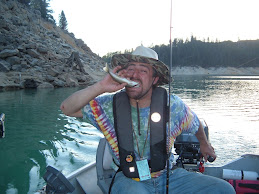
Outboard motor
From Wikipedia, the free encyclopedia
General uses
Outboard motors for a boat are developed as a self-contained unit with engine, subsidiary systems, and propeller, designed to be mounted at the stern (rear) of the craft. They are the most common motorized method of propelling small watercraft.
As well as providing propulsion, outboards provide steering control, as they are designed to pivot over their mountings and thus control the orientation of the propeller. The transmission leg in the water also acts as a rudder even when the propeller is not providing power.
When boats are out of service or being drawn through shallow waters, outboard motors can also be tipped forward trimmed up over their mounts to elevate the propeller and transmission shaft out of the water to avoid accumulation of seaweed or hitting underwater hazards such as rocks.
Types of motors
Small outboard motors are truly self-contained, with integral fuel tanks and controls mounted on the body of the motor and steered by a "tiller" directly connected to the motor. Such small motors can weigh as little as 12 kilograms (approximately 26 pounds) and provide sufficient power to move a small dinghy at around 15 km/h (9 mph), far faster than possible with oars. They are highly portable, able to be removed by simply loosening their mounting clamps. Small outboards usually use a manual pull start ignition system while larger models often have electric start similar to a car.
Manufacturers have produced large outboard designs, with sufficient power to be used on boats as long as 9 metres (30 feet) or more. Manufacturers also produce electric outboards, commonly referred to as "trolling motors", which are used on very small craft or on small lakes where gasoline motors are prohibited, as a secondary means of propulsion on larger craft, and as repositioning thrusters while fishing for bass and other freshwater species in the US, where their quietness and zero emissions outweigh the range deficiencies shared with electric cars. Diesel outboards are also available, but their weight and cost make them impractical for most purposes.
Pump-jet propulsion (replacing the conventional propeller) is available as an option on most outboard motors. Like other types of pump-jet propulsion systems, they offer virtually no cavitation, giving the boat more maneuverability and the ability to operate in very shallow water. However, the low efficiency compared to propellers has seen them restricted to specialized applications.
History and developments
The first practical outboard motor was created by Norwegian-American inventor Ole Evinrude in 1909.
Historically, most outboards have used two-stroke engines fitted with a carburetor due to their simplicity (and consequent reliability), low cost, and high power-to-weight ratios - weight issues being particularly important as too much weight over the stern of boats tends to impede their handling. However, the high specific fuel consumption and high emissions associated with traditional carburated two-stroke engines has led to the development of more sophisticated engines. Most manufacturers have marketed four-stroke engines, often with computer controls, fuel injection, variable camshaft timing, multiple valves per cylinder, and supercharging. Others have focused on developing computer controlled direct-injected two stroke engines. Either of these designs can reduce fuel consumption and emissions markedly, especially at low engine speeds, albeit at the expense of greater cost and complexity.
Marine engines also benefit from the ability to draw an unlimited supply of cooling water from the environment; this eliminates the need for radiators and cooling fans, lowering complexity and weight.
Outboard motor manual link list






